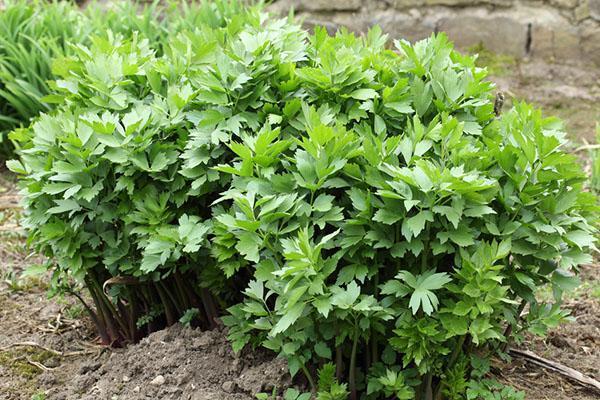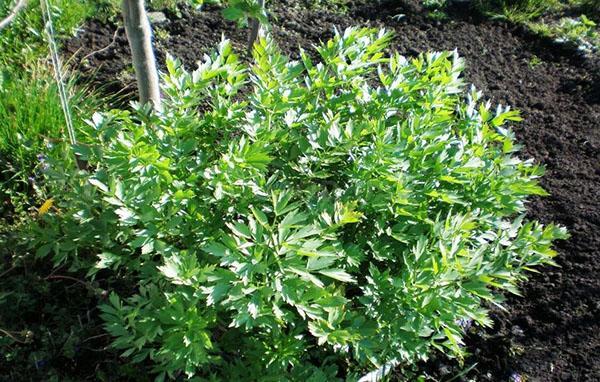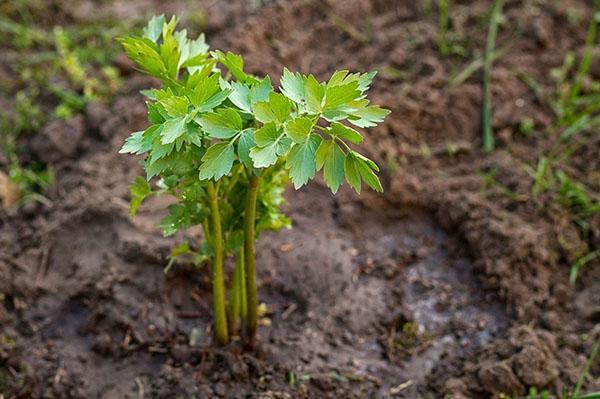Start growing lovage on your plot next season
 Lovage is a spicy perennial plant that has found medical and culinary uses. Growing lovage is within the power of any gardener, subject to soil and care requirements. It is often referred to as celery, which is a mistake. These are completely different herbs.
Lovage is a spicy perennial plant that has found medical and culinary uses. Growing lovage is within the power of any gardener, subject to soil and care requirements. It is often referred to as celery, which is a mistake. These are completely different herbs.
Rules for growing lovage in an open area

To obtain a crop of lovage in the open field, it is necessary to create the right lighting, provide temperature conditions, care and properly prepare the soil.
Lighting requirements
For optimal growth and development, the bush needs to create partial shade. When exposed to direct sunlight, the plant dies, and the lack of light will stop its growth and fruit ovary.
Temperature readings and watering
 Stagnation of water entails rotting of the root system. Watering required when the soil around the plant becomes dry (2 times every 10 days in dry weather). Despite the fact that lovage firmly tolerates frost, for optimal growth, a temperature of at least + 22 ° C is needed. When the temperature falls, growth stops. Intense heat can cause yellowing of the leaves. In this case, it is necessary to reduce the interval between waterings.
Stagnation of water entails rotting of the root system. Watering required when the soil around the plant becomes dry (2 times every 10 days in dry weather). Despite the fact that lovage firmly tolerates frost, for optimal growth, a temperature of at least + 22 ° C is needed. When the temperature falls, growth stops. Intense heat can cause yellowing of the leaves. In this case, it is necessary to reduce the interval between waterings.
Soil preparation
 The bush is quite picky about the soil: it should be loose and moist. The soil must be nutritious, regardless of whether it is clay, sandy or peaty.
The bush is quite picky about the soil: it should be loose and moist. The soil must be nutritious, regardless of whether it is clay, sandy or peaty.
Before planting on the site, you need to fertilize and loosen it. As fertilizers, you can take several components in equal proportions:
- wood ash;
- superphosphate;
- rotted cow dung;
- compost mixture;
- urea.
Regardless of the season in which the planting is carried out, lovage will die if one of the soil requirements is not met.
Planting with seeds
 Before growing lovage from seeds, you must wait until the soil is sufficiently warmed up. This happens around April. Can be sown earlier in boxes and kept at room temperature until the first shoots appear.
Before growing lovage from seeds, you must wait until the soil is sufficiently warmed up. This happens around April. Can be sown earlier in boxes and kept at room temperature until the first shoots appear.
Sowing stages:
- Soak the planting material in water at room temperature for 48 hours, changing the liquid twice a day.
- Make 20 mm deep furrows in the soil.
- Plant the seeds 10 cm apart.
- As the bushes grow, it is necessary to thin out, allocating an area of 1 m for each plant2.
Planting lovage seeds is also possible in November. In this case, the first shoots will appear in early spring.
Reproduction by dividing the bush
 Reproduction of the bush is possible when lovage is grown for at least three years. To do this, the plant must be carefully dug up, and then divided into several parts with a sharp knife or shovel. At the same time, at least three buds should remain on each bush obtained on the root part.
Reproduction of the bush is possible when lovage is grown for at least three years. To do this, the plant must be carefully dug up, and then divided into several parts with a sharp knife or shovel. At the same time, at least three buds should remain on each bush obtained on the root part.

With proper reproduction, the plant will easily take root in a new place, and after three years you can repeat the procedure. In order for the bush to fully grow and develop, it must be transplanted to a new site every six years.
Features of growing in an apartment, on a balcony
 For owners of city apartments, you can figure out how to grow lovage on a windowsill. To do this, you will need a biennial plant with a root weight of at least 10 kg. It must be cut into several parts and cut with crushed activated carbon. The resulting bushes should be planted in separate containers.
For owners of city apartments, you can figure out how to grow lovage on a windowsill. To do this, you will need a biennial plant with a root weight of at least 10 kg. It must be cut into several parts and cut with crushed activated carbon. The resulting bushes should be planted in separate containers.
All the foliage must be removed from the spice, and if there is none, cut off the top so that the stalk of 2 cm remains above the soil. loggia or a window with access to sunlight. As they grow, the greens must be cut off.
In the apartment you can grow lovage from seeds:
- sow seeds in pots with soil and leave for 1.5 months in a warm and bright room;
- wait for the first leaves, plant seedlings in individual containers;
- water regularly with water at room temperature.
An adult plant does not need special care; it is enough to follow the same procedures as with other indoor flowers.
Care rules

Planting and caring for lovage in the open field and at home are similar and include several points:
- Regular loosening and top dressing. It is better to use inorganic substances as fertilizer. A large amount of nitrogen will lead to accelerated growth, but the absence of greens and a deterioration in their taste. An ash solution is considered the best option.
- Timely weeding and foliage pruning. Growing lovage outdoors requires regular weed removal. Pruning is performed according to a certain algorithm: at the end of August, greens are completely removed from a one-year-old plant. For a two-year-old bush, the procedure is carried out in June-August. Young foliage should be removed along with the twigs, leaving a 7 cm stalk. Pruning of greenery is done 4 times a year, followed by fertilization of the soil.
- Frequent watering in a drought (when grown in a vegetable garden). It is important to observe the measure here. Excess moisture will lead to root decay, and lack of moisture will lead to discoloration and loss of taste in the leaves.
Diseases and pests

The plant can suffer from pest attacks. These include:
- Carrot fly. It manifests itself in the form of yellowed foliage and the subsequent death of the spice. The larvae cause harm by eating the roots.
- Aphid. It affects the testes.
- Septoria. It is characterized by yellow spots with black dots in the center on the foliage. As a result, the bush dries up and dies.
You can fight pests with special means, but after using them, lovage cannot be used for culinary and medical purposes.
Collection and storage of lovage
 From a one-year-old plant, only leaves are subject to collection. To do this, you must wait for the formation of umbrellas before flowering. Leaves harvested ahead of time have no nutritional value.
From a one-year-old plant, only leaves are subject to collection. To do this, you must wait for the formation of umbrellas before flowering. Leaves harvested ahead of time have no nutritional value.
You can start collecting seeds in the second year of the plant's life after they are fully ripe. After three years, the roots take on value. They are carefully dug up, washed from the ground, cut into pieces and stored in a dark, ventilated place until they become brittle. To speed up drying, you can put plant parts near a heat source, but not in the sun.
 For storing dry parts, you must prepare an opaque container with a tight lid. Keep leaves, seeds and roots separate from each other. If you study all the intricacies of care and storage, before growing lovage, you can later use it for culinary and medicinal purposes.
For storing dry parts, you must prepare an opaque container with a tight lid. Keep leaves, seeds and roots separate from each other. If you study all the intricacies of care and storage, before growing lovage, you can later use it for culinary and medicinal purposes.